| 1 | Brazil’s worst coral snake |

In southeast Brazil, there’s many snakes you could be bitten by. There’s the crossed pitviper, which hides in long grass by dirt tracks, there’s Bothrops moojeni, which lunges at people in riverside forests. Then there’s the painted coral snake, which lives on forest floors covered with thick leaf beds, which you’re most likely to be bitten by if you drop your keys and start rummaging around on your hands and knees.
Painted coral snakes (Micrurus corallinus) are found in three countries: southeast Brazil, eastern Paraguay, and a tiny portion of northeast Argentina. They’re especially abundant near Rio de Janeiro, and forests are their heartland, rarely open grassland. Painted coral snakes range from 65-85cm, with a maximum of 98cm.
This snake has both a vicious and mild side. Among South America’s 40+ coral snake species, it causes the highest number of bites annually. Yet coral snakes only account for 1% of total snakebites in Brazil. Micrurus corallinus also has a mild temperament, and will rarely lunge at people, preferring to hide its head timidly. The vast majority of bites are from people foolishly picking it up, often drunk men or curious children.
| 2 | ID signs to remember |
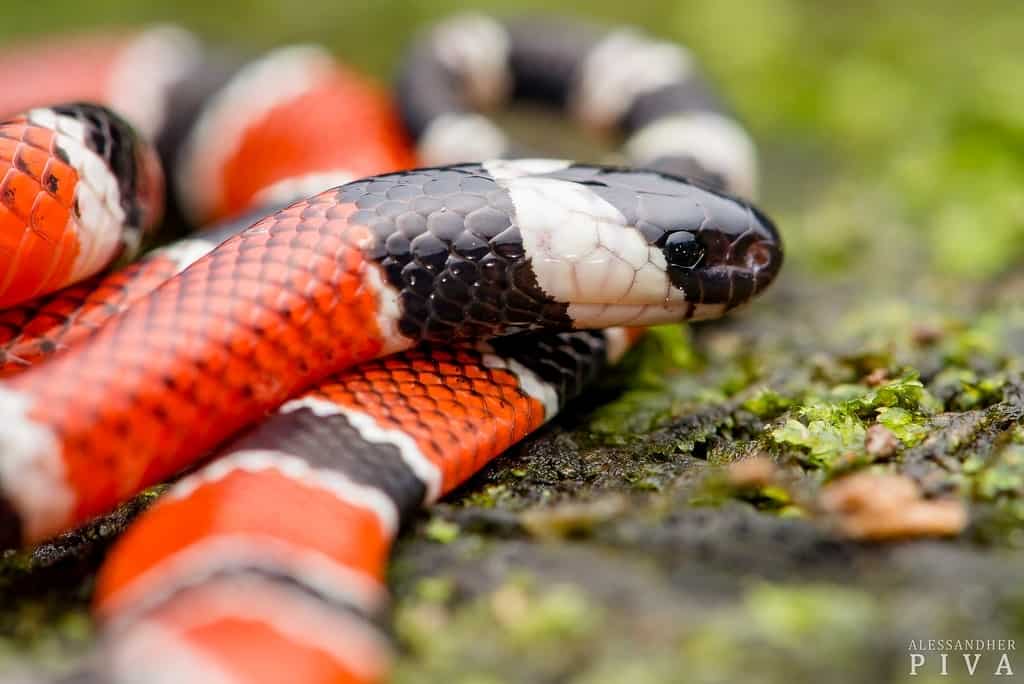
Micrurus corallinus is recognisable by its pattern of long red spaces, followed by a white-black-white pattern of thin bars, before returning to red. It actually reaffirms the old Florida rhyme of “red touches yellow, kill a fellow”, although this is only foolproof in the United States, and repeatedly fails in central and South America.
For example, the 2nd deadliest coral snake in southeast Brazil is the southern coral snake (Micrurus frontalis). This has long red spaces followed by black-yellow-black-yellow-black, but is savagely neurotoxic, despite the “red touches black, venom lack” rhyme. This pattern also makes it easy to distinguish from the painted coral snake, which it overlaps with.
The tail in painted coral snakes switches to black and white only. Its face is fully black, with no complex patterns, just a clean midnight shade. The next colour is white, which encircles its neck. Then a black scarf arrives, before the regular patterns arrive in earnest. Painted coral snakes have tiny black eyes which blend into their black face.
| 3 | Knocks brain signals off course |
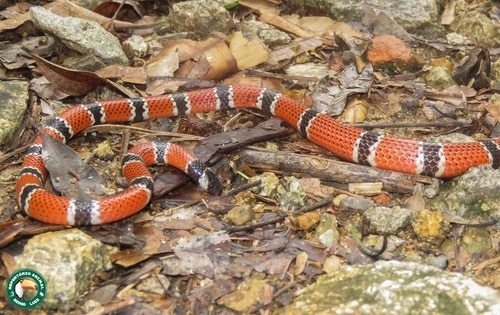
Painted coral snakes are mainly neurotoxic, causing little haemorrhaging and swelling. A detailed bite report involved a 28 year old Caucasian sailor, camped out with friends near the Brazilian city of Cachoeiras de Macacu. A biologist nearby picked up a colourful serpent, believing it to be a false coral snake. Our victim then touched the snake out of curiosity, but soon discovered the “false” coral to be the real thing. He was bitten between his thumb and index finger, on the back of his right hand, at 1:00pm. Pain appeared within minutes, followed by visual disturbances (a classic neurotoxic symptom). 6 hours later, the man arrived in hospital.
By 8 hours post bite, he was experiencing drooping eyelids (ptosis), lower back pain, tongue paraesthesia, difficulty swallowing, and double vision. There were no local symptoms whatsoever, neither swelling nor necrosis. He received antivenom 10 hours post bite, relatively late, and was admitted to intensive care, with close monitoring of his cardiovascular and respiratory health. Laboratory tests revealed few differences in bloodstream biomarkers except for a small rise in creatine kinase, a biomarker used to measure muscle tissue damage. The man was released on his 4th day of hospitalisation.
This is an example of a relatively mild painted coral snake bite, but keeping the classically neurotoxic symptoms, the opposite of the spontaneous bleeding and tissue destruction wrought by a Bothrops pitviper.
| 4 | Easily tops the bite statistics |
In 2016, a study analysed Brazilian coral snake bites from 1867 through 2014, across the whole nation. In 81 cases, the snake was identified down to the species level, and at 36 cases, painted coral snakes were easily the most common aggressor. Southern coral snakes (M. frontalis) ranked in second at 12 cases, followed by ribbon coral snakes (5), Hemprich’s coral snakes (2), and slender (1), Caatinga (1), Amazon (1), and aquatic coral snakes (1).
In three of the painted coral snakes, mechanical ventilation had to be used due to respiratory failure, including with a 66 year old man. There was also a 1 year old boy bitten who ended up on mechanical ventilation, but miraculously survived. The aggressor here was a juvenile painted coral snake, limiting the venom quantities.
The study concluded that bites were serious but mostly survivable: “serious complications such as paralysis with respiratory failure were also observed, but were comparatively rare“. The venom is highly toxic, but the yield is low. According to a 2014 study, Micrurus corallinus has a maximum venom yield of 17.6mg, with a mean of 15.5mg over 13 milkings.
| 5 | The deadliest of 9 tested |
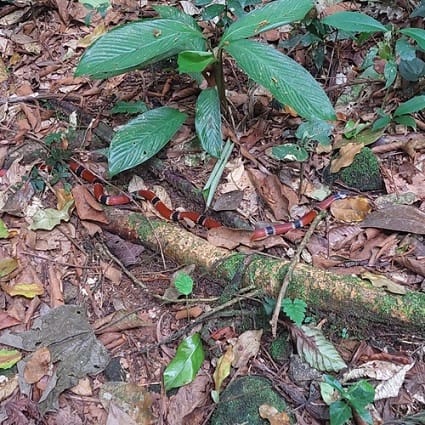
2010 saw one of the best coral snake studies to date. It was a comparison of nine species across the Americas, and in tests on Swiss lab mice, painted coral snakes ranked first for lethality. They achieved an LD50 score of 7ug/g, narrowly beating the Amazon coral snake (8ug/g) and Uruguayan coral snake (9ug/g). In last place was the Caatinga coral snake at 76 ug/g, followed by the eastern coral snake (64ug/g) and aquatic coral snake (58ug/g). Painted coral snakes rarely eat mice, but they’re a mammal just like humans, so beware.
Luckily, the standard antivenom works well. It was found to be effective against painted, southern, and Amazon coral snakes, but weaker against the ribbon and Uruguyan coral snakes. This is what you’d expect given that painted coral snakes (plus southern corals) are used in Brazil’s main antivenom, manufactured in the Butantan Institute, and featuring antibodies generated after injection into live, hyperimmune horses.
| 6 | Contains both neurotoxin forms |
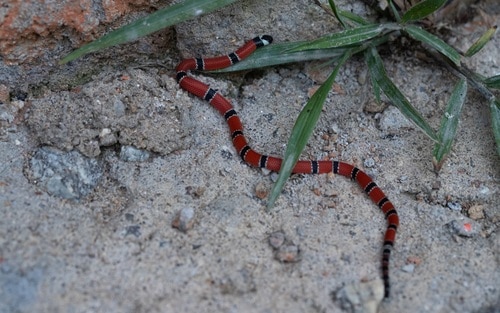
Micrurus corallinus covers all the neurotoxic bases, containing post-synaptic neurotoxins in form of phospholipases A2s, and post-synaptic neurotoxins as three-finger toxins. Post-synaptics are when neurotoxin molecules block nicotinic acetylcholine receptors in muscle cells, preventing previously released brain signals from binding. This is similar to a black mamba. Pre-synaptic neurotoxins are harder to treat, as they disable acetylcholine release from the motor nerve endings, cutting them off at the source.
The three-finger toxins in painted coral snakes are highly diverse, possibly allowing them to block a variety of receptors, while the PLA2s were less diverse. The venom also contains small quantities of serine proteases, L-amino oxidases and metalloproteinases. The latter two cause primarily local effects, and are much more abundant in rattlesnakes and other pitvipers.
Micrurus corallinus venom also had the highest hyaluronidase activity of the 9, a molecule that digests skin cells to allow easier access for deadlier toxins. Eastern coral snake venom contained the least.
| 7 | Steals your sense of taste? |
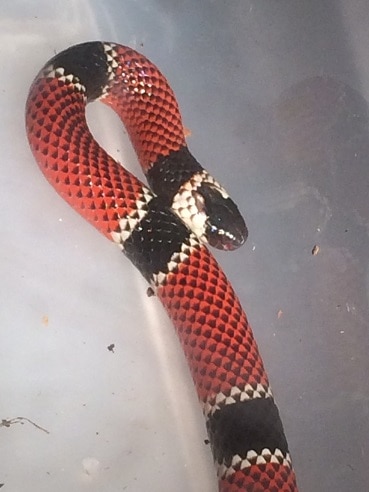
One incident involved two drunk men enjoying a barbecue in Brazil’s Sao Paulo state province. They spotted a painted coral snake, and began playing with it foolishly, thinking it was a false coral. The inevitable happened, as the intoxicated men were bitten within minutes of each other.
The presumably sobered-up duo reached hospital 16 and 19 hours later, and experienced classic Micrurus corallinus symptoms like drooping eyelids, muscle weakness, trouble swallowing, and muscular aches. There were no local symptoms, and both patients left hospital after one day, following large dosages of antivenom. But the most interesting was a delayed symptom, as both patients experienced a sudden loss of taste, 3-4 weeks after being bitten.
Micrurus corallinus has several close cousins which are easily confusable, but have secret ID differences. For example, Avery’s coral snake has the same basic patterns, but its head is pure black, while there are far fewer white-black-white sections (longer red spaces): 8-13 versus 17-21 for the painted coral snake.
| 8 | Distracts enemies with its tail |
Micrurus corallinus has a black and white head, missing any red, and their tail is identical, with the red vanishing. Rather than random, this serves a specific survival purpose. It’s part of a defensive strategy: wiggling their tail high in the air to draw potential predators away from their brain. This occurs in many coral sakes, but hadn’t been observed in wild painted coral snakes until November 27th 2021.
A Micrurus corallinus was spotted on a rotting tree stump in Parque Nacional San Rafael, Paraguay. When the scientists approached, the coral snake shifted and hid its head and upper body in adjacent leaf litter. With its tail, it did the opposite, raising it high in the air, and curling the tip, to mimic the rounded shape of a head. When scientists moved or made a sound, the snake extended its body to make the curled tail more prominent. Most of exposed lower half tail was curled in an S-shape. This tail distraction has also been observed in decorated coral snakes, Argentinian coral snakes, and Venezuelan coral snakes.
In 1979, this deception was observed in captivity, when painted coral snakes were placed against grisons (Galictis genus). The coral snake coiled up and raised its black and white tail, but also jabbed at the aggressive grison with it, once its head was safely secured. These strikes forced the grison to retreat briefly. Micrurus corallinus also thrashes its body aggressively if cornered.
| 9 | Prefers legless, elongated prey |
In 1997, scientists decided to map out this species’ exact diet, clarifying the scattered records that already existed. They gathered 512 stored painted coral snakes from museums, of which 93 still contained prey. The most common food group was amphisbaenians, an elongated reptile similar in shape to a snake. Confirmed species include Leposternon microcephalum, the smallhead worm lizard, recorded 48 times, comprising 51.1% of total prey.
Elongated amphibians called caecilians comprised 9.1% of prey, but the rest were all reptiles, including snakes. Serpents discovered in their bellies included Neuwied’s false fer-de-lance and Brongersma’s worm snake. The latter is also confirmed prey for its cousins, the Uruguayan coral snake and Argentinian coral snake.
Snakes comprised 8.6% of its diet overall. The remainder included amphisbaenians (69.3%), lizards (12.7%) and caecilians (9.6%). However, a 2021 study concluded that snakes comprised 52% of its diet, followed by amphisbaenians at 21%, lizards at 15%, and caecilians at 12%. The study revealed over 15 snakes painted coral snakes were confirmed to eat, but none were in the Bothrops lancehead family or their own Micrurus coral snake family. It’s possible that they lack immunity to venom like some snake-eaters.
| 10 | Swallows prey longer than itself |
Micrurus corallinus has a clear love for elongated, limbless prey like itself, with a smattering of legged lizards like Mabuya skinks. A painted coral snake also swallowed one of the largest prey ever in the Micrurus family. The snake was found in a 43.5cm in a garden amidst plants, looking very bloated. It didn’t thrash or flee as many coral snakes do, it just lay disturbingly still, as though it was so full it couldn’t move.
The coral snake was placed in a transport box, and a few hours later, it regurgitated a Neuwied’s tree snake (Dipsas neuwiedii). This was partially digested and exceeded its own length, at 44.0cm.
Meanwhile, painted coral snakes fall prey to Brazil’s birds, like Buteogallus urubitinga, the great black hawk. This was observed in February 2009, in Silva Jardim municipality, Rio de Janeiro. It was the edge of a forest fragment n ear an oil pipeline, and a scientists’ camera trap caught the bird pick up the Micrurus corallinus in its beak and spend 3 minutes ripping small chunks off the snake. Another confirmed predator is a snake, the long-tailed machete savane (Chironius multiventris).
